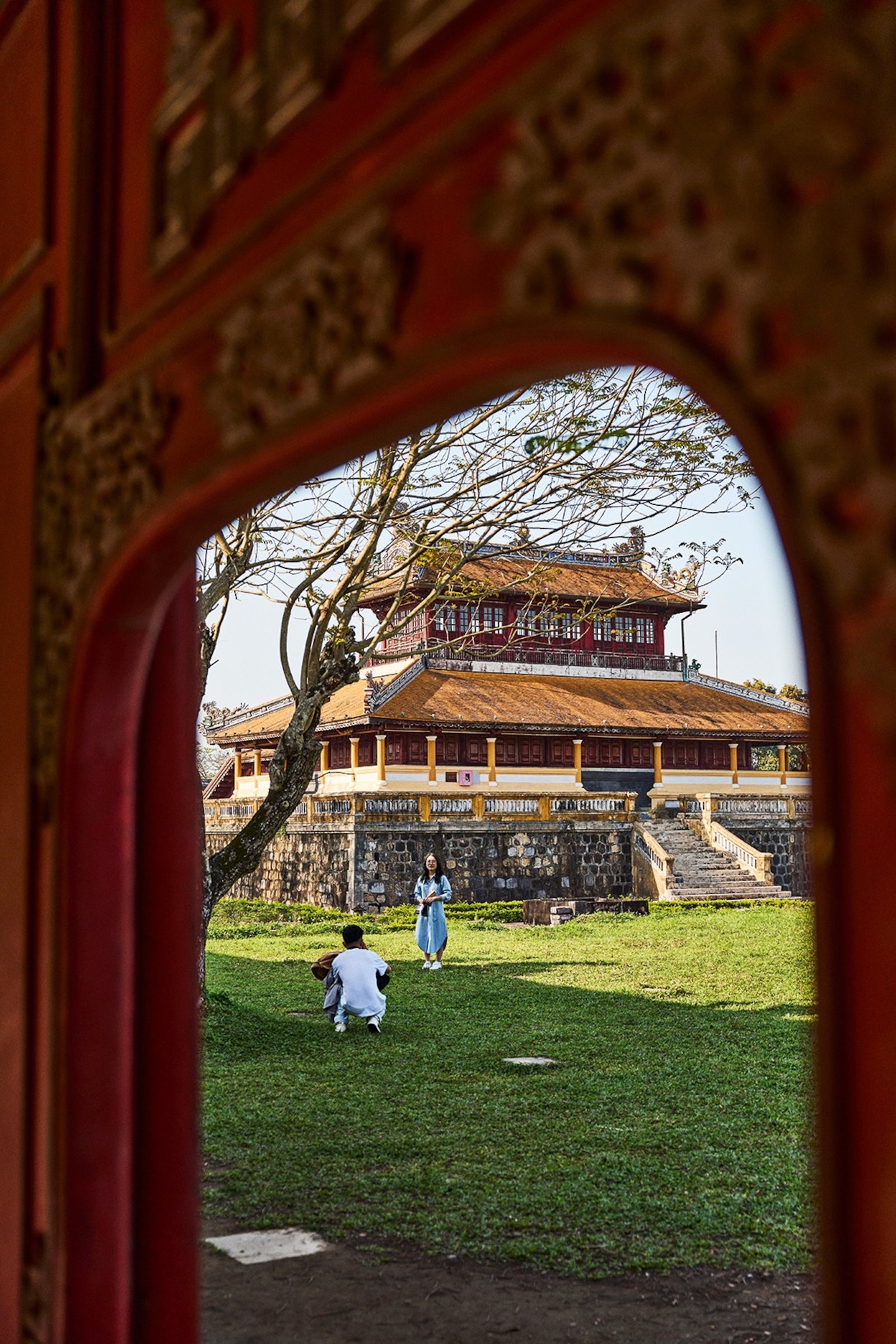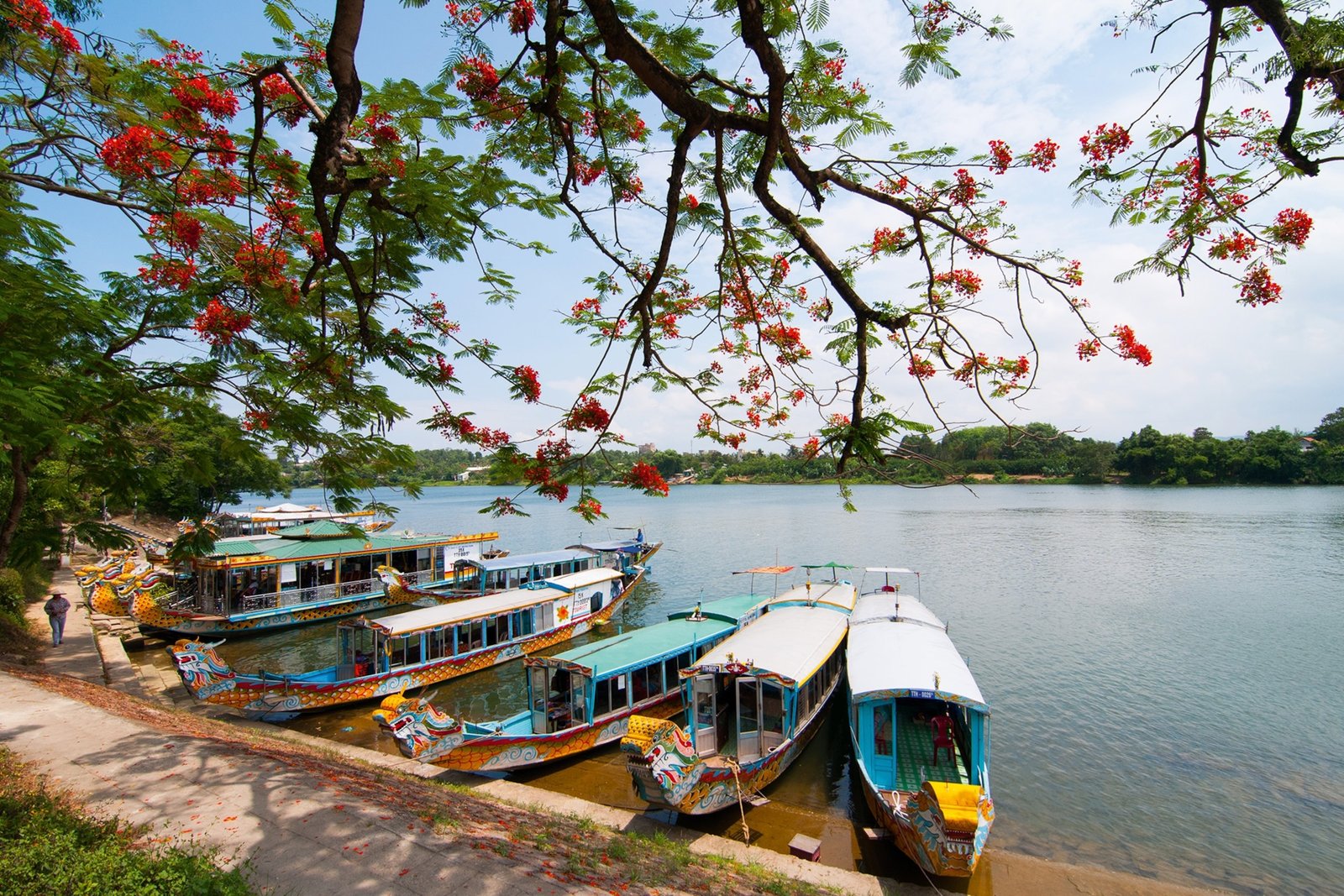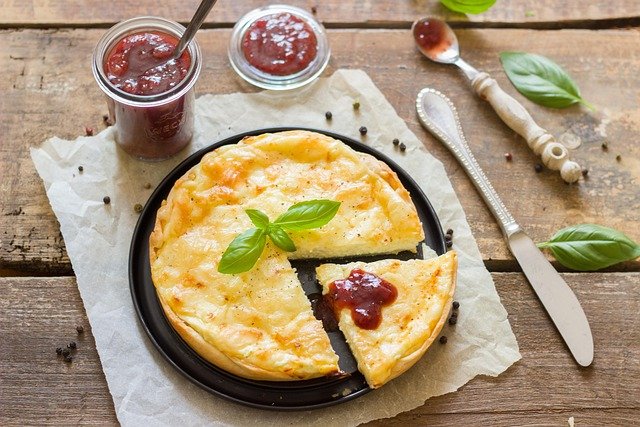This article was produced by National Geographic Traveller (UK).
The Nguyen emperors weren’t noted for their restraint,” says tour guide Quoc Dung as he leads me through the moated palaces and gated courtyards of Hue’s Imperial City. Dung — a smartly dressed, well-spoken gentleman — is being diplomatic. The facts give a more accurate picture of the Nguyens, who ruled Vietnam from Hue between 1802 and 1945. Minh Mang (r. 1820-41) had 500 wives and 142 children. Khai Din (r. 1916-1925) refused to go anywhere unless carried in a sedan chair, and insisted that his morning tea be brewed with the dew collected from lotus leaves in the palace grounds. “They weren’t the easiest people to work for,” Dung continues. “The emperor’s meals would consist of an average of 50 courses. But this kept their chefs creative.”
Despite their opulent lifestyles, the Nguyen emperors were devout Buddhists who followed meat-free diets on various holy days of the year. This, combined with their less pious proclivity for lavish multi-course meals, led their court chefs to develop one of the world’s most elaborate vegetarian cuisines, and the most sophisticated food culture in Vietnam. Today, Hue’s heritage of courtly vegetarian food is making it a hub for the growing number of visitors to Vietnam who follow a plant-based diet. “Whether Hue is Vietnam’s food capital is up for debate,” says Dung. “But it’s definitely the country’s vegetarian capital.”
The sun begins to set, igniting the imperial-yellow roof tiles of the Meridian Gate into a pool of glistening gold as Dung and I leave the citadel and cross the Perfume River, named for the scent of the flowered hills that it carries into Hue’s traffic-choked heart. The Walking Street — Hue’s historic night market — is already lively. Punters are perched on tiny plastic stools around stalls aromatic with the scent of lemongrass, peanut and Thai basil, and the air resonates with the sound of clinking cutlery and diners slurping noodles.

Hue is still regarded as the Buddhist capital of Vietnam. Today is the new moon, one of two days each month when observant Buddhists forgo meat and restaurants across the city serve traditional vegetarian and vegan dishes.
Photograph by Ulf Svane
Thanks to the Nguyen emperors, Hue is still regarded as the Buddhist capital of Vietnam. As it happens, today is the new moon, one of two days each month, along with the full moon, when observant Buddhists forgo meat for a plant-based diet, and restaurants across the city serve traditional vegetarian and vegan dishes. Dung orders us bowls of sweet, caramelised jackfruit and plates of banh xeo — crispy rice pancakes stuffed with intensely aromatic perilla leaves, mushrooms and pickled vegetables. “We call them happy pancakes,” says Dung, explaining that the nickname comes not just from their smile-like shape when folded in half, but for their delicious taste and satisfying crunch. As I retire sated to my hotel, I can see why.
“The Vietnamese don’t like the supermarket,” says Dung the next morning, as the chaos of Hue’s Dong Ba Market unfolds around us. “Everyone still comes to the market every morning to buy their produce fresh. Having fridges at home hasn’t changed that.” We’re standing in a thoroughfare, the two of us islands in a seething human river. Scooters weave around us, their riders doing business without leaving their seats, waving wads of notes in one hand and grabbing grocery bags with the other. The smell of petrol mingles with the aroma rising from cauldrons of shrimp paste, while stalls sag under the weight of thousands of snails and clams, foraged from the river.
Most of all, though, the market is dominated by a cornucopia of tubers, leaves, flowers and fruiting bodies. Bitter melons, looking like shrivelled cucumbers, are piled high in crates. Baskets overflow with the gnarled roots of galangal, Southeast Asia’s answer to ginger. Lotus seeds are strung on threads like bead necklaces. Green peppercorns burst from their stems like bonsai grapes on tiny vines; Dung buys some and we chew on these juicy spice bombs as we browse the market stalls for ingredients. Last night’s street food experience stoked my appetite, so I’ve booked into a cooking class, in the hope of unlocking some of the secrets of Hue’s vegetarian cuisine.

Chef Nguyen Thi Thuy Nhien says her vegetarian restaurant is one of several in Hue that’s focused on healthy eating.
Photograph by Meogia Photo, Getty Images
Dung buys carrots and king oyster mushrooms, bags of dried banana blossom, fragrant bunches of kaffir lime leaves and a box of savoury green figs — a Hue speciality. Ingredients secured, we get into a waiting car and are taken to An Nhien Garden, Hue’s leading vegetarian restaurant, which emphasises plant-based dishes and ingredients sourced from local, organic farms. I’m met by Nguyen Thi Thuy Nhien, the young chef who co-owns this restaurant with her sister. The beautiful old building housing the restaurant is their 16th-century family home, and as she leads me through she explains how they converted part of it in 2021 to create the successful restaurant where we’ll be cooking.
Dark pillars and folding screens of ironwood are carved with ornate dragons, bats and maze-like symbols representing shou — the Chinese symbol for good fortune and longevity. We emerge into the peaceful garden, decorated with colourful abstract paintings and sculptures, where I’m put to task chopping the vegetables and then the figs, whose insides sweat with beads of white sap as soon as they’re exposed to the air. Nhien directs me in the creation of va tron, a vegetarian salad invented in the Nguyen courts, which we assemble by combining the figs, carrots and mushrooms, seasoning them with soy and fish sauce.
The result is a light yet satisfying dish with a tofu-like, almost meaty texture. I wash the salad down with tangerine-infused Chinese tea, as Nhien talks about the plant-based revolution taking root in the city, focused on the use of healthy, sustainably sourced ingredients and feeding on Hue’s long history of courtly vegetarian cuisine. “Many of us in Hue are Buddhist, and traditionally we’ll eat vegetarian food a couple of days a month,” she says. “But people got in the habit of eating whatever, as long as it wasn’t meat — it could be junk food, it could be anything. Now, we’re helping people realise that you only get one body, and you have to love it every day of the month.”
Nhien says her vegetarian restaurant is one of several in Hue that’s focused on healthy eating; others include The Garden Cafe and Hong Nga, both in the Imperial City. Similar to An Nhien Garden, they’re helping to shift the perspective of locals with organic, locally grown produce. “It’s not about going full-time vegetarian,” Nhien says. “It’s just about a little less meat, a little more green — and being a little healthier every day.”
Published in the July/August 2025 issue of National Geographic Traveller (UK).
To subscribe to National Geographic Traveller (UK) magazine click here. (Available in select countries only).


